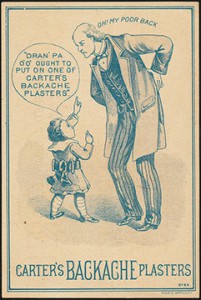 My own recent troubles with backache prompted me to do some research into how to sew without getting backache! If you’ve suffered from this you’ll understand how painful it is, also frustrating when you have quilting projects you want to get on with. This article “Sewing Ergonomics – How to Sew Without Getting Backache” will get you back on track for pain-free sewing!
My own recent troubles with backache prompted me to do some research into how to sew without getting backache! If you’ve suffered from this you’ll understand how painful it is, also frustrating when you have quilting projects you want to get on with. This article “Sewing Ergonomics – How to Sew Without Getting Backache” will get you back on track for pain-free sewing!
How Does it Happen
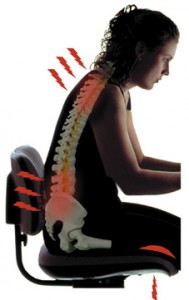 Sitting for too long in a “bad” position is asking for trouble. The strain on the upper back and lumbar region can lead to chronic back problems.
Sitting for too long in a “bad” position is asking for trouble. The strain on the upper back and lumbar region can lead to chronic back problems.
- When we sit with rounded and elevated shoulders and our head pushed forward this places stress between the top of the neck and skull and also the upper shoulders and base of the neck.
- Sitting for long periods with forward tilting hips, an increase in the curve of the lowers spine and a protruding stomach puts stress over both hip joints and lower back.
In their article in the Medical and Engineering & Physics journal “A novel system for the dynamic assessment of back shape” Taylor, Consmüller, and Rohlmann write that “Low back pain is an increasing problem and can be aggravated by prolonged static posture.”
In other words, sitting hunched up over a sewing machine for a long time is likely to cause you trouble.
Ergonomics in the Sewing Room
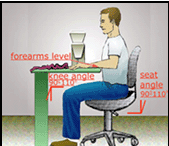 Sewing machine height should be so that your elbows are 90º to your upper arms when you are sewing. If your table is too low you’ll end up hunched forward which strains your back, shoulders and neck. If it’s too high you’ll need to lift your shoulders which will make tired and tense.
Sewing machine height should be so that your elbows are 90º to your upper arms when you are sewing. If your table is too low you’ll end up hunched forward which strains your back, shoulders and neck. If it’s too high you’ll need to lift your shoulders which will make tired and tense.- Have a large enough work surface to fit your machine. Make sure your legs fit underneath comfortably while using the pedal, and that your feet are flat on the ground.
- An adjustable chair is ideal for helping you get things right.
- Tilt the machine forward slightly if sewing for long periods.
- For your cutting table the same principles apply, we spend a long time cutting!
- If you table isn’t quite right there might be simple solutions like cutting the legs down or using wooden blocks to heighten it.
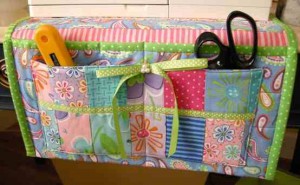
- Make a simple sewing machine apron like the one in the image from meandmysisterdesigns.com. It keeps tools close at hand and save you from twisting awkwardly.
- Make sure you have good lighting, this is often overlooked. Scrunching forward to enable you to see your work better is a recipe for getting backache!
- Your choice of sewing machine can also back a factor, Difficult to thread, hard to reach function buttons and poor lighting can also contribute to back problems when sewing.
MY 2 TOP TIPS
- Cutting is the thing which hurts my back the most and most of my sewing friends complain of the same thing. I use a dog grooming table for this! At 5’6″, a normal table height is just a little too low, dog grooming tables are higher. One of my cutting mats fits almost perfectly on the surface. The one I have is similar to this grooming table just without the arm. It also folds away flat for handy storage!
- Chasing your foot pedal across the floor can put extra strain on your back knees and hips. Get a piece of non-slip matting to put your pedal on. Alternatively, make yourself one of these non-slip sewing machine foot pedal pad
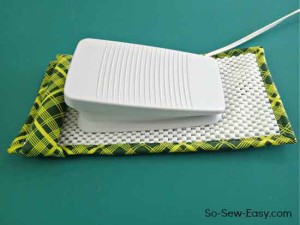
Correct Posture
Sit correctly with a straight back, don’t hunch your shoulders or bend forward towards the machine. Bend your whole neck, not just the head.
Use a lumbar support pillow and try not tense up, stay relaxed. I know, easier said than done when you’re focused on a project!
Move around, stand and stretch every 15-20mns. To stretch your shoulders hold onto the door jamb at either side, lean through the door and stretch the muscles in your chest. Only stretch as much as feels comfortable not till it’s painful for about 15/20 seconds. Pull your neck back if you’ve been sitting with it forward.
Strengthen the abdominal and ham-string muscles. Choose an exercise routine appropriate for your age and level of fitness. This website has excellent advice and information about exercise for spine health. This is another useful article on making modifications to your home and office.
An exercise you can do while walking around is suck in your tummy, like you were buttoning up a pair of trousers. Count to 10 but keep breathing and walking around, tricky at first but you soon get the hang of it! Doing this exercise several times a day will help strengthen the transverse abdominal muscle.
Interestingly, I read an article recently called “Lost Posture: Why Some Indigenous Cultures May Not Have Back Pain.” It seems that our lifestyle, in many ways, can be to blame for the many bad back problems we see today. You can read more about the article here.
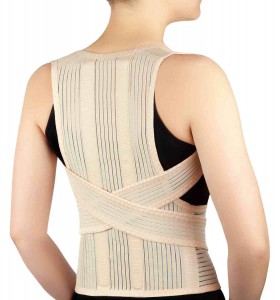 Back support braces work for some people by helping to instill and maintain good posture habits. After being worn for a while, the effect stays even when the brace is taken off. There are many different makes and models on the market so it’s important to find one that fits correctly and is comfortable. Speak to your health professional for the best advice.
Back support braces work for some people by helping to instill and maintain good posture habits. After being worn for a while, the effect stays even when the brace is taken off. There are many different makes and models on the market so it’s important to find one that fits correctly and is comfortable. Speak to your health professional for the best advice.
Get Advice!
Finally, if you’re having recurring back problems speak to your health professional.They can advise you on all the above points and make sure you have everything you need for pain-free sewing.
Do you have back problems? What are your best tips for avoiding or alleviating backache?

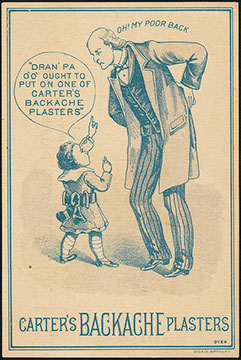
I absolutely know what you are talking about here with backache! Posture makes a huge difference as well as getting up from time to time.
Thanks for the great tips and information.
Angela
Thanks Angela, having suffered from severe back pain recently I now know how important Sewing ergonomics are!
I don’t have control of what my chair is at work, unless I wanted to buy a new one of my own.
My computer hair at home is very comfortable.
But, comfortable or not, every couple of hours, I get up stretch and then go out and take a walk around the block.
I’ve suffered with bilateral sciatica for about 40 years. I’ve learned to apply some preventative measures; I watch my weight, lift with proper form, I stretch, meditate to relieve stress and exercise several times a day.
I get aches, I’ve slipped on the ice, but I’ve never taken anything stronger than an aspirin. I haven’t seen a chiropractor or missed a day of work because of back pain in 20 years. I have learned to live with my sciatica.
Did you ever find out what caused the sciatica in the first place Phil? My chiropractor said it could have started very early, like when I broke my leg at 15yrs, or carrying children on my hip (I have 4 kids). I agree with the meditation, makes a big difference doesn’t it. 🙂
Hi Kathy. I have a lot of problems sitting at my laptop, so I know what you mean! The trouble is we get so engrossed in what we’re doing the time flies by and we forget to take a break. I have a beep on my phone that goes off every now and then to remind me to stop and stand up!
Cheers. Peter
There’s probably an app for that Peter! It’s the same sitting at a laptop, hunched up, we forget what a toll it takes. Thanks for the comment. 🙂
Again great site and useful information on avoiding backache.
Thanks Tony, glad you enjoyed your visit. 🙂
Hi Kathy, This is such fantastic and essential information on the importance of posture while working at a desk. Likewise I paid the price for not getting the correct chair and moving around sufficiently at the outset. The resulting backache meant that I had many visits to the chiropractor. So I reckon that I could have spent that on a decent chair in the first instance! Ah well we live and learn 🙂
Thankfully I now have a good ergonomic chair (well worth the investment) and I put a timer on to remind myself to get up and move around. Of course we shouldn’t forget the shoulders too as these can get a little hunched. So I like to do some arm circles – like I am swimming backstroke or crawl.
This really is becoming a growing problem with so many of us spending hours on end at a desk, so it’s just great that you have educated us here on back prevention.
All the best,
Janice 🙂
It was a bad bout of backache that prompted me to research into sewing ergonomics. Like you I should have paid attention from the outset. I like the look of the back braces, I’m thinking of trying one of those.
Thanks for the positive comment Janice. 🙂
Back pain is definitely no fun and I’ve suffered my fair share of it. I can easily understand how it would affect one who is sewing as well. Leaning forward for too long is hard on your body and I can see right now that I need to adjust my sewing machine height! Thank you for sharing, as this will be a big help. 🙂
We get so engrossed we don’t think about sewing ergonomics do we! Glad you enjoyed the article and thanks for visiting. 🙂
I completly understand the suffering of having back pain. I slipped on some ice some years back and pulled a muscle in my back, I couldn’t sit, I couldn’t stand, I couldn’t lay down. Everything I tried just plain hurt. The doctor gave me some strong pills, I didn’t like taking them but I did.. for a few days anyways until I cpuld tolerate the pain without them. I returned the rest to the pharmacy caise I did jot like taking them. Now it seems it doesn’t take much for my back to get sore. I don’t sew but I do rebuilt pumps and compressors at work and when I sit there hunched over this machine all day, I’ll feel for sure later on that evening and the next few days afterwards. I’ll ask my boss for an adjustable chair and I’ll try some of your other advice as well. thanks
Oh no Dan that sounds as if it was so painful. There are lots of good ergonomic chairs now. Not sure where you live but in the UK there are employer obligations which include proving ergonomic equipment. Thanks for the comment. 🙂
What a lovely and helpful post! I get backache so easily but sewing can get really addictive and you don’t realise how much your back hurts until you get up. Thank you for this.
Yes, I think it’s a common problem with all us crafters, get so engrossed in our work! I think the back support brace is a good idea, kind of does half the support for you.
Glad you enjoyed you visit and thanks for leaving a comment. 🙂
I constantly get trouble with my back and have gone through many hours of physio with it. I’m 6 ft 3 and quite thin – posture is not great. I can completely sympathize with this article although I had never thought about sewing being a culprit before – interesting stuff!
Chris
The article I linked too was very interesting, the indigenous people rarely suffer from backache. Generally, their spines have much less of an “S” shape and that seems to be a big factor in prevention. Their lifestyle also mean muscles are kept much “tighter.”Spending too many hours sitting down, whether it’s for sew and quilting or something else clearly doesn’t help! Thanks for stopping by and leaving a comment. 🙂
Yes I know what you mean by having back pain because my mother did a lot of sewing in her days and in those days she had to do most of her sewing by hand by sitting down. Now she has a sewing machine desk but she has slowed down in her old age with sewing but it still gives her some back pain while she sews. I think this post is going to help a lot of people that do a lot of sewing as it is very informative with the facts to help prevent t he back pain while you sew.
Willie
It does help to have sewing machine table set at the right height, hopefully your Mother has hers adjusted correctly. I do hope this article helps, I’ve known people give up their hobby because of backache when there’s really no need with the correct tools etc. 🙂
Kathy,
Great article.
Never had problems with backache until recently. I just placed the blame on getting old.
However, it may be more likely sitting in front of this computer for too many hours during the day, since the knee surgeries. Hopefully when I can be active again in the garden and flower beds the backache will disappear.
Joe
I know age can be a factor in getting back problems, but it doesn’t need to be that way according to research I’ve read. Hopefully, once your knees have recovered you’ll get more active again, you must miss working in your garden. Keep me updated, I’d love to hear if being more physically active helps your back pain. 🙂
Kathy, I don’t sew but, I sit for long periods of time at my computer. I especially like your idea of the lumbar support pillow. I will have to look into getting one of these,
Sometimes I take to take a break and lie down for a few minutes to rest my back
How often do you take a break while sewing?
I try to take frequent breaks, but sometimes, I get so engrossed, especially making a quilt, that I forget. I have a dog grooming table which I put my cutting mat on, it’s the perfect height for me!
Let me know if you get a lumbar support pillow and how it works for you. 🙂
My knees, hips, and Calgary bother when sewing. Besides breaks do you have recommendations for chairs, foot rests, etc. Thank you!
I would say the most important thing is having a chair that’s the right height so your hips are square and your feet are flat on the floor without any strain. An adjustable height chair with a mesh back and waterfall edge (helps with knees) works for me. I have one similar to this one from Amazon
I did try a foot rest, but it got in the way when I was using the foot pedal, the adjustable height chair works much better for me when I’m quilting.
Let me know how you get on. 🙂
All good info that I recently tried when sewing caused me several days of neck and shoulder pain. However, it took me awhile to realize that with my sewing machine in the plexiglass surround it was farther from the edge of the table causing me to have to reach 4 inches farther than without the plexiglass. I removed it and pulled the machine to the edge of the table closer to me. Instantly helped with my pain. I had the correct table height and my adjustable secretary chair was at the correct height. I hope this comment may help anyone else who has tried the rest and is still in pain.
Hi Joyce, I always sew with my machine quite close to me and hadn’t even thought about distance from user being a problem. Thanks for taking the time to leave some invaluable advice!
I didn’t see that factor of not reaching on any other article like this online either so thanks for letting me mention it. I was in a wreck in 1999 and the neck injury from back then is surely a factor for me. Having the machine closer means I don’t crane the neck now. Thanks!
It’s a great tip Joyce, and nice that you’re able to sew despite your neck injury. 🙂
Hi, when you say to tilt the sewing machine forward, do you mean tilt it towards you or away from you… I’m a bit confused
Tilt it slightly towards you. This has the effect of straightening up your back. 🙂
Hi Kathy, I’ve noticed that every time I sew, my right hip hurts after. It’s not a mechanical issue but I can’t find much on what causes this. Usually it’s after about 10-15 minutes. I saw one comment on another website where the lady mentioned supporting her pedal leg but I’m not quite sure what she meant and there was no contact info given. Have you heard of this problem?
Hi Christy
A wedge-shaped foam cushion used sideways under your hip, to support the leg that’s using the foot pedal. Wedge dimensions are 15 1/2″ x 10 1/2″ x 2 1/2″ (on one side only). Play around with the positioning to find what works best for you.
Hope this helps. 🙂
You could also try raising your pedal. I put mine on top of a cardboard box, so I’m not reaching for it and pulling my right hip forward. This keeps my hips square and my backside firmly planted in the chair. Worth a shot!
My shoulders really start aching when I sew…I’ve tried seeing chiropractors but it starts throbbing again after a few hours.this is really aggravating because I spend most of my day sewing! And advice to fix my shoulder pain?
The first thing is to make sure your eyes are ok and you’re not hunching over because you can’t see properly! I found with the correct glasses the shoulder ache eased a lot. The next thing is to heighten your table slightly, I didn’t need much.
Remember to take breaks. The last thing I did was take up swimming, this really strengthened the back and shoulder area for me and was very effective.
By the way, those thread nets for the bigger spools are the same thing that are placed over the larger dahlia blossoms in the floral department when they’re delivered. Ask your local grocery store florist to save those for you, because the toss the by dozens
Beautiful article. I’ve got the complete recipe for disaster: a tiny sewing space, a toy machine I can’t see, and really bad lighting. My sewing table looks like it was made for a child. I have no room! Now I know exactly what to fix.
I sometimes have back pain, but my primary problem is my right hip. Days when I sew, I cannot sleep because it hurts so much & I cannot get comfortable.
I don’t get the table height thing. In the drawing, your person’s elbows are at bust height, not at waist height where real people’s elbows are.
Given that, I’ve tried to get the angle right, and my table is very low to the floor as a result, because the sewing machine bed is 4 – 6″ thick, raising your work surface by that much. Even with this low height and my forearms parallel to the floor, my upper back is still in agony after about 20 minutes, and even after a rest, the pain comes back after about 10 minutes, then 5 etc.
I don’t understand how else to arrange my table and chair other than this height adjustment which is supposed to be correct but does not stop the pain AT ALL.